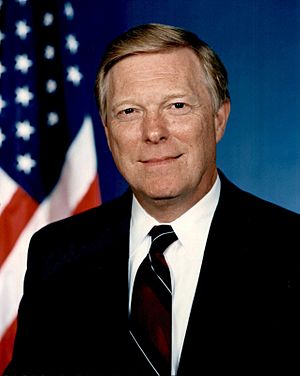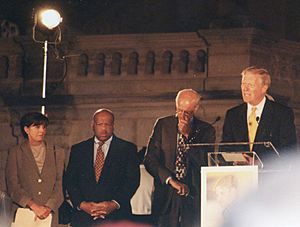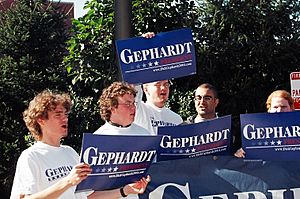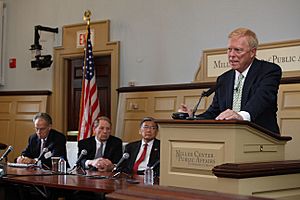Dick Gephardt facts for kids
Quick facts for kids
Dick Gephardt
|
|
|---|---|

Official portrait, 1997
|
|
| House Minority Leader | |
| In office January 3, 1995 – January 3, 2003 |
|
| Whip | David Bonior Nancy Pelosi |
| Preceded by | Robert H. Michel |
| Succeeded by | Nancy Pelosi |
| Leader of the House Democratic Caucus | |
| In office January 3, 1995 – January 3, 2003 |
|
| Preceded by | Tom Foley |
| Succeeded by | Nancy Pelosi |
| House Majority Leader | |
| In office June 6, 1989 – January 3, 1995 |
|
| Speaker | Tom Foley |
| Whip | William H. Gray David Bonior |
| Preceded by | Tom Foley |
| Succeeded by | Dick Armey |
| Chair of the House Democratic Caucus | |
| In office January 3, 1985 – January 3, 1989 |
|
| Leader | Tip O'Neill Jim Wright |
| Preceded by | Gillis William Long |
| Succeeded by | William H. Gray |
| Member of the U.S. House of Representatives from Missouri's 3rd district |
|
| In office January 3, 1977 – January 3, 2005 |
|
| Preceded by | Leonor Sullivan |
| Succeeded by | Russ Carnahan |
| Member of the St. Louis Board of Aldermen from the 14th Ward | |
| In office 1971–1976 |
|
| Personal details | |
| Born |
Richard Andrew Gephardt
January 31, 1941 St. Louis, Missouri, U.S. |
| Political party | Democratic |
| Spouse | Jane Gephardt (m. 1966; died 2024) |
| Children | 3, including Chrissy |
| Education | Northwestern University (BS) University of Michigan (JD) |
| Military service | |
| Allegiance | |
| Branch/service | |
| Years of service | 1965–1971 |
| Unit | Missouri Air National Guard |
Richard Andrew Gephardt (born January 31, 1941) is an American lawyer and politician. He represented Missouri's 3rd district in the United States House of Representatives from 1977 to 2005. As a member of the Democratic Party, he held important leadership roles. He was the House Majority Leader from 1989 to 1995. This meant he was the second-highest-ranking Democrat in the House. Later, he became the House Minority Leader from 1995 to 2003. In this role, he led the Democrats when they were not the majority party.
Gephardt also ran for President of the United States in the Democratic primaries in 1988 and 2004, but he did not win the nomination. He was also considered as a possible running mate for vice president several times. After leaving politics, Gephardt became a lobbyist. This means he works to influence government decisions on behalf of groups or companies. He started his own firms, including one that helps with public affairs and another that advises on labor issues.
Contents
Early Life and Education
Richard Gephardt was born in St. Louis, Missouri. His father was a milkman. Gephardt graduated from Southwest High School in 1958.
He was an Eagle Scout, which is the highest rank in the Boy Scouts of America. He also received a special award called the Distinguished Eagle Scout Award.
Gephardt went to Northwestern University and earned his bachelor's degree in 1962. While there, he was president of his freshman class. He then studied law at the University of Michigan Law School. He earned his law degree in 1965.
In 1965, he became a lawyer in Missouri. He also served in the Missouri Air National Guard until 1971.
Gephardt is married to Jane Gephardt. They have three children named Matt, Katie, and Chrissy.
Local Government Service
Gephardt served as an alderman (city councilor) for the 14th ward in St. Louis. He held this position on the St. Louis Board of Aldermen from 1971 to 1976. During his time on the council, he was part of a group of younger aldermen. They were sometimes called "The Young Turks" because they wanted to bring new ideas.
Serving in Congress (1976–2005)
In 1976, Gephardt was elected to the United States House of Representatives. He represented the 3rd District of St. Louis. He was re-elected 13 more times, serving in Congress for nearly 30 years. He decided not to run for re-election in 2004. Gephardt supported the bill that made Martin Luther King Jr. Day a federal holiday.
Presidential Campaign in 1988

Gephardt ran for the Democratic nomination for president in 1988. He was one of the first to announce his candidacy in February 1987. He spent a lot of time campaigning in Iowa. He started to gain support in Iowa after running ads about trade issues. He won the Iowa caucuses and the South Dakota primary. He also finished second in New Hampshire. These early wins made him a strong candidate.
However, his campaign struggled to raise enough money to compete in other states. He lost badly in the "Super Tuesday" primaries in March, winning only in Missouri. Gephardt ended his campaign after losing in Michigan. Although he didn't win the nomination, his presidential campaign made him well-known.
Leadership in the House


Because of his presidential campaign, Gephardt became more visible. In June 1989, his fellow House members elected him Majority Leader. This made him the second-highest-ranking Democrat in the House, after the Speaker, Tom Foley. Gephardt served as Majority Leader until January 1995.
In 1994, the Republican Party gained many seats in the House. This meant they became the majority party. Gephardt then became the Minority Leader. He led the House Democrats when they were not in control. He worked to help Democrats win more seats in elections from 1996 to 2000. However, the Democrats did not regain the majority until 2006, after Gephardt had left Congress.
Gephardt helped raise money for many Democratic candidates across the country. He supported many of President Bill Clinton's plans. However, he and his union supporters did not agree with some "free trade" agreements, like NAFTA. During the impeachment process for President Clinton, Gephardt led a walkout in the House.
In 2000, Vice President Al Gore considered Gephardt as a possible vice presidential candidate. Gore eventually chose Senator Joe Lieberman. In the 2002 elections, Democrats lost more seats in the House. Gephardt decided not to run for re-election as House Minority Leader. He stepped down in January 2003. This allowed him to focus on his next presidential campaign. Nancy Pelosi was elected as his successor.
Presidential Campaign in 2004
Gephardt announced his second run for president on January 5, 2003. His daughter, Chrissy, publicly shared her story while helping him campaign. Gephardt became a strong supporter of gay rights after this.
Many people thought Gephardt was too old-fashioned to win the presidency. His campaign struggled to raise as much money as other candidates. He supported the Iraq War resolution, which made some liberal activists unhappy. He promoted a plan for universal health care, and many labor unions supported him.
In early 2003, Gephardt was leading in polls for the Iowa caucus. However, by August, another candidate, Howard Dean, took the lead. The race became very competitive. In the end, Gephardt finished fourth in the Iowa caucus. After this disappointing result, he ended his presidential campaign.
After dropping out, Gephardt was again mentioned as a possible running mate, this time for John Kerry. However, Kerry chose John Edwards as his running mate.
| Dick Gephardt 2004 presidential campaign endorsements |
|---|
|
Senators
Representatives
Governors and Lt. Governors
State Legislatures leaders
Organizations
|
Political Beliefs
Over time, Gephardt's political views changed. When he was first elected to the House in 1976, he held more traditional social views. .....
His views on economic policy also changed. He supported some tax cuts in 1981. But later, he strongly opposed similar tax cuts by President George W. Bush. He believed the money should have been used for health care instead. Gephardt is known for supporting economic policies that help working families. He supports universal health coverage, which means healthcare for everyone. He also supports fair trade and progressive taxation, where wealthier people pay a higher percentage in taxes.
On October 10, 2002, Gephardt voted to allow the invasion of Iraq. He was an early supporter of the war. However, three years later, he said that his support for the war was a mistake.
Life After Congress
Gephardt's political career ended on January 3, 2005. That month, he started his own consulting and lobbying firm, Gephardt Group. He also joined a law firm, DLA Piper, as a strategic advisor.
As a lobbyist, Gephardt has worked for various groups. For example, he has worked for the Republic of Turkey. He has also served on the boards of several large companies, including Ford Motor Company and United States Steel Corporation.
In July 2007, Gephardt supported Hillary Clinton for president. He was also mentioned as a possible vice-presidential choice for Barack Obama in 2008. His congressional documents are kept at the Missouri Historical Society for people to study. In 2005, Washington University in St. Louis opened the Richard A. Gephardt Institute of Public Service. This institute helps students learn about being active citizens and leaders.

Gephardt has been very involved with the healthcare industry. He has advised large insurance companies. In 2010, he became the chair of the Board of Trustees for The Scripps Research Institute. This institute focuses on medical research. In 2016, Gephardt also helped start a healthcare group called SolidaritUS Health. Its goal is to make quality healthcare more available to working families.
Gephardt has also worked as a lobbyist for Boeing. He advises Spirit Aerosystems and is on its board of directors. In these roles, he has been involved in labor negotiations. In October 2022, Gephardt helped launch the Council for Responsible Social Media. This project focuses on how social media can affect children, communities, and national security. In May 2024, Gephardt gave a speech and received an honorary degree at Iona University in New York.
See further
- Electoral history of Dick Gephardt
See also
 In Spanish: Dick Gephardt para niños
In Spanish: Dick Gephardt para niños






